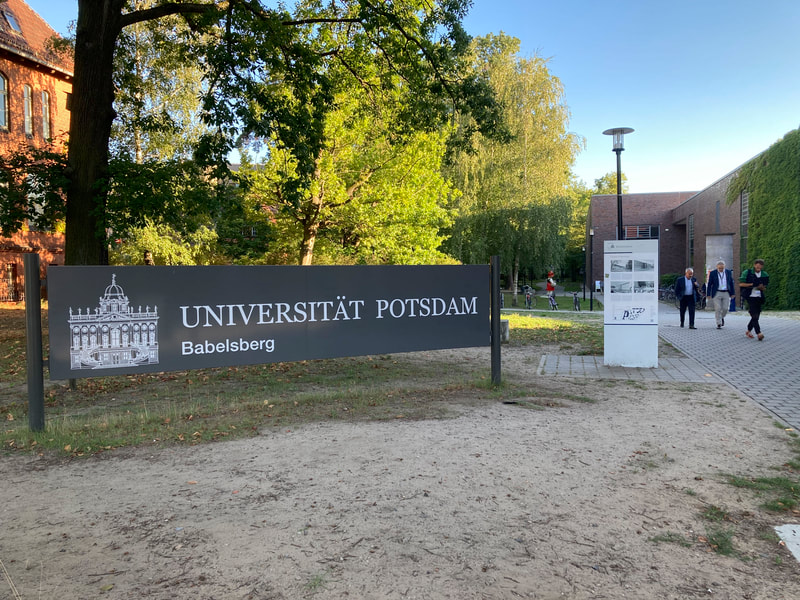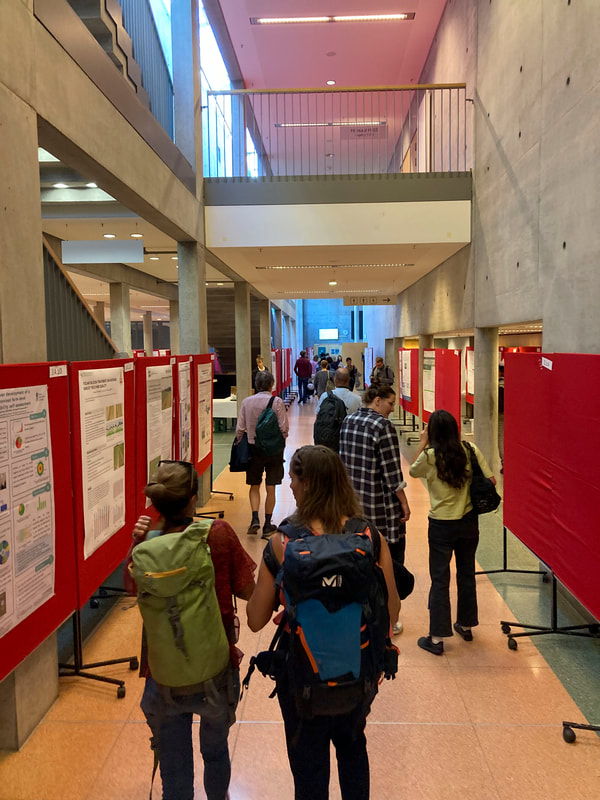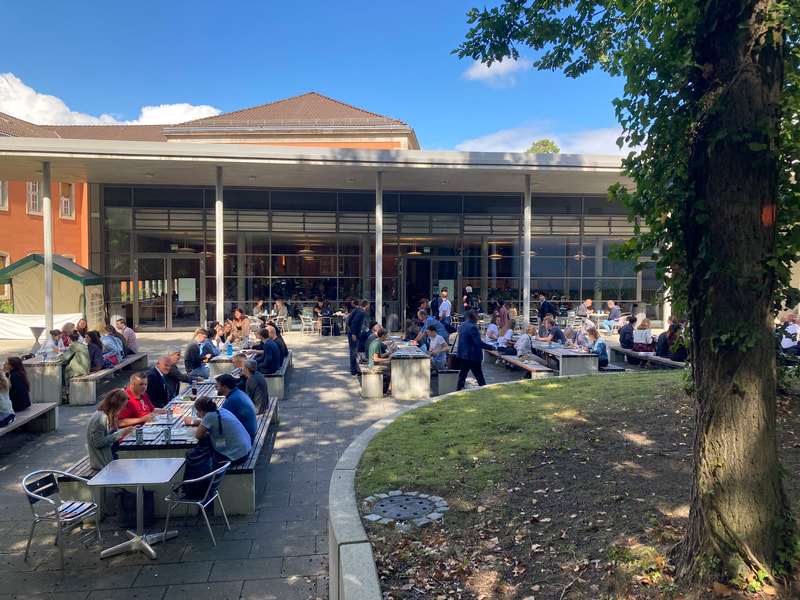|
The European Society of Agronomy biennial meeting covered research on soil health, reduction in chemical fertilizing and pesticides, and how to bring science and society closer together to accelerate innovation in sustainable production. Agriculture is going through a transformation in Europe. The European Green Deal and the EU's Farm to Fork strategy increasingly limit the use of chemical pesticides, such as glyphosate, and push towards nature-based solutions in weed and pest control. The war in Ukraine jeopardizes grain exports from "Europe's bread basket" and fertilizer exports from Russia, both threatening the global supply chain of food and agrochemicals. At the same time, consumers demand more local produce, which creates opportunities for regional markets, shorter supply chains, and products that cause fewer transport emissions. On top of this, climate change exposes crop and livestock production to more extreme drought, heat, and rainfall. Actionable research and development have a big role to play in the transformation of agriculture. Horizon Europe and its predecessor Horizon 2020, funding programs by the European Union, have been funding research aimed at bringing together researchers and practitioners to accelerate innovation in agriculture. For example, by 2027, the Horizon Europe Soil Mission will fund 100 so-called "living labs" and "lighthouses" across Europe to advance research and practices towards healthier soils. Against this backdrop, agricultural researchers met at the University of Potsdam, Germany for one week last August and early September, at the biennial meeting of the European Society of Agronomy. Embracing the increasing digitization of Agriculture 4.0 and the push towards more environmentally friendly practices, the conference ran under the motto “Diversification & Digitalisation – Trends that shape future agriculture”. As living lab researcher, I was most interested in collaborative, actionable research with farmers, conservation organizations, policy makers, and other non-scientist. As this was my first conference since moving back to Germany at the end of 2021, I was also eager to learn about advances in model development, agricultural production, natural fertilizers, and pesticide reduction on this side of the pond. Participatory and transdisciplinary researchParticipatory and transdisciplinary research involve the public and expert stakeholders and use their expertise, or simply the power of the crowd, to improve research. Participatory research can be used to augment and improve computer models. Citizen science projects, like the Mückenatlas at ZALF, or the Cooperative Observer Network of the US National Weather Service, are considered participatory research. A frontrunner in this research is INRAe, the French National Institute for Agriculture, Food, and the Environment. One challenge to combine information from participants with mathematical models, because the two rarely talk the same language. Marine Albert, a Ph.D. student at INRAe (France), and colleagues developed SMART variables to use in a vulnerability assessment for maize production. These SMART variables (specific, measureable,assignable, realistic, time-related, coined by George Doran in 1981) convert survey responses from farmers and are used in DPSIR, a quantitative model framework. Working with farmers as equal partners and reimbursing them fairly for their time was essential for her success. How should we measure transformation of agricultural systems towards sustainability? Sophie Plassin and colleagues (INRAe) identified gaps in assessing the performance of conservation agriculture and its ability to cope with climate change in temperate zones. Most methods, they found, are focused on the field or farm scale over short times (<5 years), without considering the “big picture” (larger-scale and longer-time). They also found, that assessments are too often focused on crop productivity with little attention to social and economic aspects. However, these aspects are important criteria for transforming the agri-food system, according to a recent publication of the EU Standing Committee on Agricultural Research (SCAR). Maryline Darmaun and colleagues (INRAe) worked with stakeholders to evaluate 14 methods to assess agroecological transitions, to develop a prototype for these transitions and then test it in a village in Senegal. Replacing chemical pesticides with alternative methods to control pests on fields, such as Integrated Pest Management (IPM), is another challenge in transforming agricultural systems. Much work has been done in labs, but testing methods on real fields involves research on a different scale. Sandie Masson (Agroscope Changins) and Nicolas Munier-Jolan (INRAe) developed IPMWORKS, a European network of 246 trial farms in 16 countries (e.g., the Julius-Kühn-Institut in Germany) to develop a holistic IPM that integrates crop rotations, mechanical weed management, precision pest management, and decision support systems to aid site-specific management (here is a video about their work). What difference can seasonal climate forecasts make in crop management? Marlene Palka (Ph.D. student at IPB Vienna and research assistant at IIASA in Austria) conducted on-farm experiments on four farms in eastern Austria, comparing crop management that followed her seasonal climate forecasts (forecasts for the next 1 to 12 months) to conventional management informed by seasonal averages calculated from observed historical data. Seasonal forecasts did improve decision making in general, but not so much in extreme conditions, like heavy rainfall, extreme heat, and severe drought. This is a common problem in seasonal forecasting, because extreme conditions are particularly difficult to forecast. NitrogenNitrate is a necessary fertilizer in farming, but overuse causes it to wash out of the soil into creeks, rivers and lakes. This is a major problem in conventional farming that uses synthetic fertilizer, because it can cause eutrophication of streams and lakes, and because fertilizer is expensive (both in the US and the EU, in part due to the war in Ukraine). However, this is also a problem in organic farming, which use legumes or manure fertilizer. Legumes are plants that help bind nitrogen from the soil or air (where it is the most abundant gas), store it, and release it when needed. Tackling practical hurdles in reducing nitrogen wash-out, Malick Ouattara, Ph.D. student at INRAe and AgroParisTech, worked with farmers, researchers, and advisors to develop crop mixes that require less synthetic nitrogen, reduce nitrate leaching, and use available nitrogen more efficiently. Ph.D. students Tsvetelina Krachunova (ZALF) and Florian Tröber (HTW Dresden) used ribwort plantain (Spitzwegerich), a legume, as cover crop and found 20 to 40% less nitrate leaching in fields with ribwort, a very good result (video about their research). Less leaching reduces pollution downstream and reduces costs of fertilization for farmers. Ribwort as forage has antibacterial effects in sheep stomachs and reduces emissions of N2O, a potent greenhouse gas, from sheep. However, ribwort seeds are expensive (ca. 200 Euro per ha), which makes an expensive source of forage. Its effects on other soil organisms are also largely unexplored. Farmers also need to remove ribwort as a cover crop before it matures and forms seeds or else its seeds will germinate and grow in the following grain crop. Shorter supply chainsGlobalization is evident in many supply and value chains in agriculture, Luis Lassaletta (Universidad Politécnica de Madrid) explained in her keynote talk. For example, in animal production, grain crops are used as high-protein feed. The grain is often grown in one country, but the fertilizer used on the fields is produced in another country, and the grain forage is eventually shipped to yet another country where hungry livestock are awaiting. This creates an imbalance, because livestock manure (rich in nitrate) accumulates far from where it was used to grow crops. This drives soil and water nitrification, while mineral nitrogen has to be produced in a very emission-intensive way to be used in crop production. Emissions and pollution could be much lower in shorter supply chains, where producers and consumers of agricultural goods are closer together. FoodSHIFT2030, an EU Horizon 2020-funded project, is working with administrators, citizens, businesses, and scientists to transform the agrifood system first in nine and later in 27 European cities, including Berlin, towards shorter supply chains, which could benefit local producers and create fewer emissions. Technical and technological aspectsThere is no shortage in technical and technological approaches to reducing agricultural emissions, creating shorter supply chains, and yet produce affordable food in a sustainable way. Senthold Asseng, who in 2021 took over the professorship in digital agriculture at TU Munich, discussed indoor vertical farming (such as infarm,www.infarm.com) as a way to allow year-round farming with fewer inputs, reduced pest risk, and yields that are “impossible in conventional farming.” Robin Lieb and colleagues (Julius-Kühn-Institut, Germany) tested “if pesticide-free cereal production is possible” in a project they called “NOcsPS.” They combined conventional and organic production methods by replacing chemical weed removal with mechanical weed removal (by farm robots) and by using less mineral fertilizer (they called this system MECS). Their method did reduce diseases, but also revealed problems with some fungi and weeds, which thrived on the mineral fertilizer. Intercropping grows two different crops in the same field at the same time. Wopke van der Werf (Wageningen University and Research, The Netherlands) explained, there are different ways to intercrop two crops, for example in alternating rows or by choosing crops that grow at different rates and don't compete for the same soil nutrients. This allows both crops to be harvested separately. Intercropping can reduce the spread of pests and diseases, and it increases the land efficiency ratio, which means the two intercropped varieties need less space to achieve the same yield compared to if both were planted separately. Intercropping systems differ based on where they are located. For example, Chinese systems benefit from cheaper manual labor for harvesting, which allows for a greater variety of crops to be combined. European systems with higher labor costs are restricted to combinations that are suitable for machine harvesting. Kairsty Topp (Scotland’s Rural College) studied intercropping in ReMIX, also an EU Horizon 2020-funded project (www.remix-intercrops.eu) and found that intercropping improved pest and disease control, Nitrogen storage in the ground, and increased yields by 20-40% compared to monocropping. Intercropping affects habitats of farm birds and other critters that live on fields, which is still largely unexplored and an area of active research, for example by Dirk Apeldoorn (Wageningen University and Research). Modeling, decision support, and experimentationLab and field experiments, like NOcsPS or ReMIX, help improve agricultural models that predict crop yields and ecological benefits of changes in agricultural management. These models can be connected to user interfaces that allow managers to use them to improve management decisions. Mathieu Delandmeter (University of Liege, Belgium) evaluated how well the French STICS model simulates biomass production, evapotranspiration, yield, plant nitrogen, and carbon exchange in a four-year crop rotation in Belgium. Ashifur Shawon, researcher in the project RYE-SUS (Julius-Kühn-Institut, Germany), tested four different calibration strategies for the crop-growth simulator DSSAT for German growing conditions using crop, climate, and soil data. Frauke Geppert (ZALF) works on the German Naturschutz-App (NatApp 2.0), a smartphone and web app co-developed with farmers that allows planning, tracking, and compensating biodiversity measures on farms (so-called agro-environmental schemes). Alesia Perego (University of Milan, Italy) described LANDSUPPORT, a land management tool with a simple user interface that that is connected to the ARMOSA model to aid decision making. What to take away?ESA 2022 tried to connect the technical aspects of agricultural research, social science studies, and showcase approaches to transfer scientific advances into practice. The conference motto, “Diversification & Digitalisation – Trends that shape future agriculture,” nodded to the challenges of our time for sustainable food production, both poised to change what foods we consume and how we produce them.
Much of the conference still focused on production aspects of the transformation to sustainable agriculture, appearing like we can “science” our way out of the climate crisis. Perhaps that's the case, but for scientific innovations to succeed in the real world of farm management, policy making, and food production, it requires collaborative between scientific, political, private sector, and societal stakeholders. It seems, participatory, transdisciplinary, and living lab approaches are still a niche (11 out of 242 poster and presentations had „participatory”, „participation“, „participating“, or „participated“ in the title or abstract. None contained “living lab”.). I’m excited to see what ESA 2024 (in Rennes, France) holds. With INRAe as organizer and Edith le Cadre as the new ESA president, I’m hopeful that living lab and other participatory approaches will play a larger role. A call for contributions to the ESA 2024 program will be available on the ESA website: www.european-agronomy.org Related reading: Reallabore in Agrarlandschaften: Gemeinsam mit Praxis, Wissenschaft und Politik zu Lösungen für die Transformation des Agrarsystems (2022, German) |




 RSS Feed
RSS Feed
